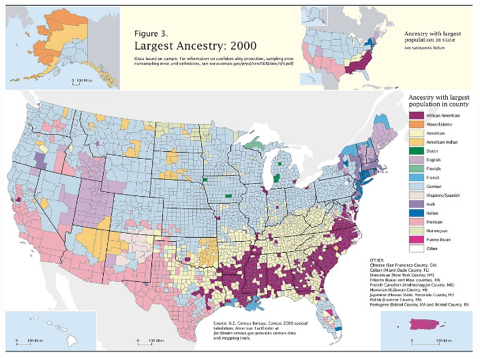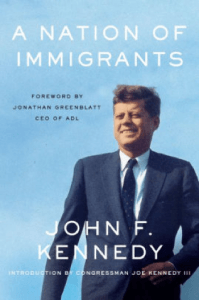
This is a book review of “A Nation of Immigrants” by John F. Kennedy. The review was written by Sharath Patil.
These States are the amplest poem,
Here is not merely a nation but
A teeming Nation of nations.”
-Walt Whitman[1]
In 2018, Congressman Joe Kennedy III (D-MA), re-published a classic by his great-uncle, former U.S. President John F. Kennedy: A Nation of Immigrants. Although the book has been widely celebrated for decades, Joe Kennedy intended to demonstrate the relevance of JFK’s principles and values to debates around immigration policy today. As the first Roman Catholic U.S. president, Kennedy’s election was a critical milestone in this nation’s path to becoming a more inclusive country. Throughout his presidency, Kennedy did not forget his own immigrant roots nor that of most Americans. Irish by heritage, Kennedy wrote with great respect for the suffering that so many Irish immigrants to the United States endured – particularly during the Irish potato famine and under British rule.
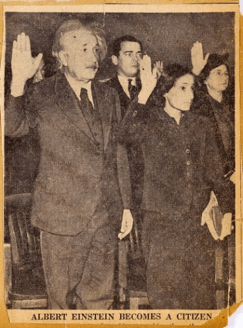
Albert Einstein, a Jewish immigrant who fled Nazi Germany, attends a naturalization ceremony with his daughter, Margot. [2]
In my mind, it was a tall, proud city built on rocks stronger than oceans, windswept, God-blessed, and teeming with people of all kinds living in harmony and peace; a city with free ports that hummed with commerce and creativity. And if there had to be city walls, the walls had doors and the doors were open to anyone with the will and the heart to get here. [3]
Kennedy exhorted every branch of every level of the U.S. government to be “constructed and inhabited by men aware of their great trust and their great responsibility.” Id. This vision captured Kennedy’s biblical attitude towards treating the alien with openness and warmth. In Matthew 25:35 (NIV), it is written: “For I was hungry and you gave me food. I was thirsty and you gave me drink. I was a stranger and you welcomed me.” The concept of treating visitors, refugees, and migrants from other lands with hospitality and kindness is a theme present not only in Christianity, but in all of the world’s major religions. Kennedy sought to develop an attitude towards immigration that was grounded in spiritual principles and conscious that we are all – at some point or another – immigrants.
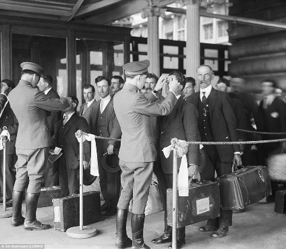
Immigrants at Ellis Island, New York, were subject to rigorous health examinations. Many were sent back to the countries they came from. [4]
Organized charity, scrimped and iced
In the name of a cautious, statistical Christ.”[5]
Kennedy also warns against the dangers of hateful, xenophobic tropes, fears, and beliefs that have unfortunately characterized so much of U.S. history. These tired arguments, he says, remain the same and are rooted in ignorance and unfounded fears.

U.S. citizens of Japanese descent being forcibly transported to internment camps during World War II. [6]
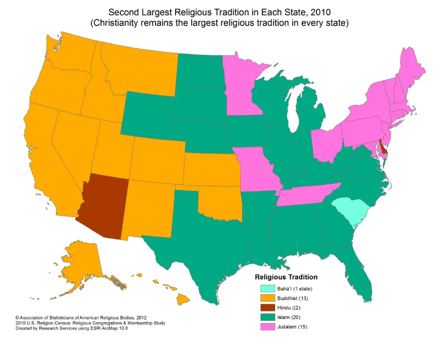

Maps 2 & 3: “Peelback maps.” These maps uncover a stunning degree of underlying religious and linguistic diversity in the U.S. [8] [9]
References
- Walt Whitman, “Published Works” (183).
- Google Arts and Culture, https://artsandculture.google.com/exhibit/QQrk18h6
- John F. Kennedy, “A Nation of Immigrants” (xviii).
- The Daily Mail, https://www.dailymail.co.uk/news/article-2771227/Haunting-pictures-Ellis-Island-hospital-treated-1-2million-immigrants-set-open-visitors-tours-art-installation.html
- John F. Kennedy, “A Nation of Immigrants” (65).
- Huffington Post, https://www.huffpost.com/entry/trump-and-the-75th-anniversary-of-the-japanese-internment_b_58a9b700e4b026a89a7a2c8f
- U.S. Census Bureau, American Factfinder, factfinder.census.gov
- Washington Post, https://www.washingtonpost.com/blogs/govbeat/wp/2014/06/04/the-second-largest-religion-in-each-state/?utm_term=.3fef354036fa
- Census Bureau American Community Survey. Map by Ben Blatt/Slate. https://slate.com/culture/2014/05/language-map-whats-the-most-popular-language-in-your-state.html
About the Author:
 Sharath Patil is a fellow on economics and trade at the University of Maryland’s Bahá’í Chair for World Peace program. He recently graduated with a J.D. from the University of Oregon School of Law and has a bachelor of science in supply chain management from Arizona State University. He has significant academic and professional experience in international trade, global logistics, and commercial diplomacy.
Sharath Patil is a fellow on economics and trade at the University of Maryland’s Bahá’í Chair for World Peace program. He recently graduated with a J.D. from the University of Oregon School of Law and has a bachelor of science in supply chain management from Arizona State University. He has significant academic and professional experience in international trade, global logistics, and commercial diplomacy.

